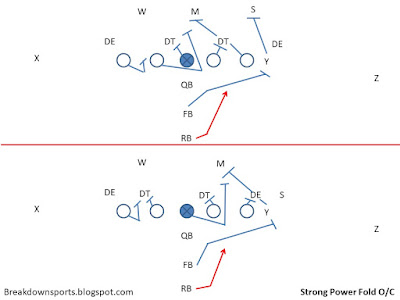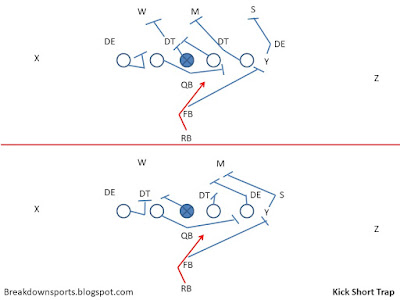Title : Football Fundamentals: I-Formation RB Fold and Trap Run Plays
Review : Football Fundamentals: I-Formation RB Fold and Trap Run Plays
Football Fundamentals: I-Formation RB Fold and Trap Run Plays
This is a series post with lots of play diagrams. Where it lacks depth, it hopefully makes up for with breadth. The goal of this post is to demonstrate the many run game nuances that are at your disposal, outside the very basics that you can find almost anywhere. I will point out some key attributes for the plays, but for the most part the diagrams will stand alone outside a brief description. This post is limited (out of necessity) to strongside plays that are given directly to the RB. It does not include FB runs, or QB runs, or H-Back, Wing, TE, or WR runs. It also doesn't include option plays. Those are things for future posts.Why did I select an I-formation, which is mostly going out of fashion, and how do I expect this information to be utilized? The I-Formation is a classic 2-back set that, by the time it was implemented, had the benefit of a lot of football history. It is also a highly adaptable run formation, along for offsets, for H-backs, and other aspects that allow essentially any run concept to be incorporated into its framework. And that's the important bit: you can look at an I-Formation run play and easily carry it forward to many modern formations. For instance, by altering footwork and possibly timing, any of these plays can be utilized in the following:
- 2-Back Shotgun Runs (with the second back potentially being a FB, an H-Back, a Wing, or a Sniffer)
- 1-Back Shotgun QB Runs (utilizing the RB as an added blocker)
- 1-Back Shotgun Read Options (the read of a run-run option, run-pass option, or pass-run option take the place of the additional blocker).
Many of the best current offenses often circle back to old formations. In the NFL, along with the modern spread concepts, you see a lot of the best offenses utilizing Wing T concepts. This set of plays does the same where it can (though, again, recognize that the option packages and fake packages are not included in this post, so it is somewhat limited). Below, you will see each play blocked against the two fundamental Even Fronts (4-3 Over and Under).
Isolation Plays
Gap and Pull Plays
Fold and Trap Plays
Counter Plays
Pull Replace Plays
Zone and Zone Counter Plays
Zone/Gap Combo Plays
Draw Plays
Gap and Pull Plays
Fold and Trap Plays
Counter Plays
Pull Replace Plays
Zone and Zone Counter Plays
Zone/Gap Combo Plays
Draw Plays
Let's group fold and trap plays, and the fact that many "trap" plays can become fold plays depending on the front (and how you want to coach the play).
Folds
Fold Power O
A tight version of Power O. The backside OG will fold to the backside LB. This means the frontside double needs to move one LB playside. A good switch for teams starting to flow hard playside to account for the additional frontside gaps created by traditional Power O.
Lead Fold O
Similar to the Bear Iso, you now effectively have two lead blockers. The primary difference here is that the fold is always coming from the backside OG. In this way, it looks like Lead Single Power O, but run tighter.
Power Fold O/C
Similar to Fold O, only you are now folding either the Center or the OG depending on the front.
Split Fold O/C
Rather than mimicing Power O, now we are running a split flow play. Effectively this becomes an Iso play with the fold blocker as the lead blocker. The FB accounts for the backside EMOL, allowing the backside OT to work directly to the second level, which really opens up the cutback possibilities in the event the downblock portion of the fold gets beat playside.
Lead Fold G/T
For teams that run pin and pull or down schemes, this effectively forces the defense to flow playside, and the "fold" hits inside of that flow. Note you can also fold from the backside to create a cutback lane if the front side down block gets beat playside (as seen with the backside OG folding vs the over front, the Center could do the same against the Under front).
Split GUT Iso
Another way to get into an Iso run play, this time with a "GUT" fold. This is unique as the fold is back toward the play. You'll see this more often on draw plays, but, for instance, Tony Dorsett's 99 Yard TD play was a single back variation of this play. First, we look at split flow, which will simulate an Inside Zone Run. Note the GUT (tackle folding under the G) can convert to the guard folding under the Center, based on D alignment.
Note: For GUT Iso, you may want to convert the fold to a trap to improve angles. This play against an Over front is one example, where C/LG can release to second level and you trap instead of fold. Another example would be against an even front with 2i on both sides.
Kick GUT Iso
Now with a kick block. This will simulate more of stretch or belly type play before hitting back upfield. Note the kick block against the under front, to allow the MIKE to be reached, lock the Y on the SAM and kick the DE.
Lead GUT Iso
A double Iso play. This gives you a little bit more Big-on-Big action and makes some angles a little easier up front.
BOB Short Trap
A short trap is typically going to trap the two DL away (i.e. there is one DL between the puller and the DL that gets trap blocked). Depending on the front, the trapper can be either the BSG or the C. The FB here is going to lead up to the backside LB. The RB is going to receive the handoff on the backside of the play before working back frontside, this allows the trap block to clear and prevents penetration from ending the play at the handoff.
Split Short Trap
Similar to the BOB Short Trap, just the FB is going to account for the backside EMOL and the BST can work directly to the backside LB. This allows the OL to get to the second level quicker.
Kick Short Trap
The FB is now going the other direction, similar to Power O. If your Power O is getting beat by the playside DL, this is a pretty decent change up. It allows the OL to work directly to the second level to seal them to the backside. Note that there are a few ways of playing the trap defender: you can engage him momentarily with the OL aligned inside of him to prevent him from squeezing down (if a team is great at block down, step down, this could be important); or you can try to reach underneath him with the OL outside of him; or you can just release with the easiest path to the assigned blocker. It may depend on your OL talent, the defensive scheme, or the talent of the defender you are trapping.
We will talk later about the "Influence Counter"; this is similar, with the subtle difference that against an Under front the trap will be on the NT; i.e. we are trapping the first DL playside of the Center instead of two DL away. The Lead blocker will adjust because of this, working backside initially before going a gap inside the trapper.
BOB Long Trap
Now we are trapping three DL away. To get there, the easiest means is to pull the Center or Guard, depending on the front. The FB is going to work through the gap created by the puller, preventing any penetration on his way up to the second level LB, the split flow helping to hold the LBs to the backside of the play to allow a run lane between the kick block and the down blocks.
Lead Long Trap
Long Trap with a lead block. This accounts for a playside LB and allows the front side to truly block down to the second level.
Split 3 Trap
You're always trapping the 3-Technique. If there are two 3-Techniques, you'll trap the strongside 3T.
Split Nose Trap
You're trapping the nose from the opposite side OT. The FB will replace the pulling OT. Be aware that you may have to momentarily engage with the NT before working to the second level, particularly if run from under center.
Tackle is going to short trap the first defender opposite. Here the FB is going to split flow to replace the pulling OT. Again note concerns about NT penetration. You can deal with this by engaging momentarily with the OL aligned inside of him, or attempt to scoop underneath him with the OL aligned outside of him which may give a better angle to the 2nd level (but is more difficult to execute).
Down G
Moving away from inside traps, now we are going to look at frontside traps. Down G can be blocked as a pin and pull variation or with a defined puller. Here, we look at it with a defined puller and a gap/man scheme.
Wham Down G
Here, we look to pull the OL with at least two blockers outside of him, but does not have a defender aligned in the gap to the backside of him (i.e. the PSG or Center). The wham block can be utilized as a cutback, but typically it's there as window dressing to give a split flow appearance to the backside of the play. The frontside will flow with pin and pull action, the backside will stay home due to the split flow while the OL can work directly to the second level to prevent them from pursuit of the Down G play.
Double Down G
You will see this a bit with read teams, with the QB having an option to keep to run down G on the backside of the play (and typically a read of the MIKE). Here, the backside Down G is window dressing, the backside Down G is there to hold the backside LB. The FB is responsible for the first defender (DL or LB) playside to prevent that player from chasing or blitzing the puller.
Wham Double Down G
Rather than leading playside, you now get some benefit of split flow (which theoretically can set up a weakside Down G run off similar Double Down G action).
Influence Trap
Now that the frontside short trap has been established, the DL will start chasing that puller. They can be influenced, and then trapped themselves.
* Note, all nomenclature is my own, though attempts to be fairly consistent with standard. As plays get added, you can add "tags" to base plays (as I have done) or create single word names to take the place for shorter communication.
Such is the Article Football Fundamentals: I-Formation RB Fold and Trap Run Plays
sports films Football Fundamentals: I-Formation RB Fold and Trap Run Plays, hopefully can be useful for all of you. Alright, that's all for posting reviews of sports films this time.
























0 Response to " Football Fundamentals: I-Formation RB Fold and Trap Run Plays"
Post a Comment